On last Friday, we visited DocLab Expo: Immersive Reality. This program’s concept was described as follows.
We are immersing ourselves deeper and deeper in a digital reality, surpassing both our wildest dreams and our greatest nightmares. From the end of privacy to the future of storytelling, how do we redefine the documentary genre in the digital age?
We found that there were some similar points with our own project’s concept. Immersive Reality, especially for Oculus Rift projects, have gone really far on game production. We can find a lot of interesting and imaginative VR games on the internet. But experiments on actual world are not enough, we think.
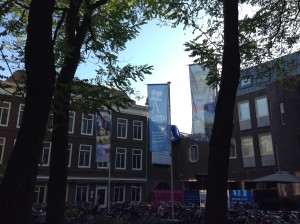
We experienced a few works on the expo. We’d like to introduce some projects that gave us inspiration.
Strangers with Patrick Watson
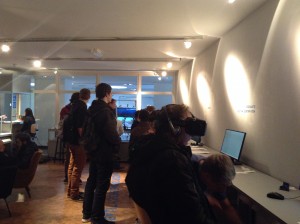
People can put on the virtual reality headset and feel as if you’re physically present in Canadian musician Patrick Watson’s Montréal studio loft on a crisp winter’s day. Without interaction provided for the user, this immersive documentary just gave us a very natural and comfortable experience. People will feel very relax with the live music inside.
The Machine to Be Another
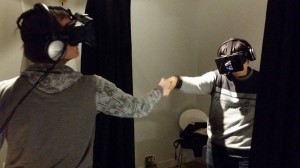
The Machine to Be Another provided a chance for a woman to experience having a man’s body, for a physically fit jogger to find out what it’s like to be wheelchair-bound, and for a black person to live in the body of a white person. This interactive performance installation is based on low-budget experiments such as first-person cameras, and Oculus Rift DK1, but it caused international uproar in experimental anthropology, gender studies and gay studies circles because it offers a totally new approach to understanding identity. The makers themselves are intensely ideological and see their machine as an instrument for boosting empathetic responses, making the world a better place in the process.
Assent
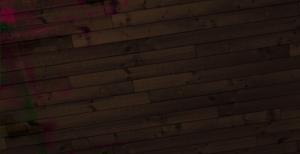
Oscar Raby’s Assent offers a moving immersive documentary experience that plays out in the virtual past. Through the Oculus Rift headset, media artist Raby transports the audience to a digital version of Chile in 1973. After a short introduction, you walk in the footsteps of Raby’s father. With him, you’re witness to an execution of a group of prisoners captured by the military regime – an army that Raby’s father was himself a part of. This work is a very good example to tell us how to use color in an immersive environment.
We had a script writing workshop at AVROTROS last Thursday. We got very precious advice about storytelling and filmmaking for virtual reality. Some ideas are really useful for the production of our own final project. We’d like to pick up some insights we need deal with and tips we got from this workshop.
- Come up with 4 camera positions, and the types of scene genre application they would be effective for.
Every camera position has its feature. In a VR movie, it’s not wise enough to use cuts as frequently as traditional movies. Normally, we need pick up one camera position as the main position. So we should consider about at least 4 camera positions and each one’s advantages. In that way, we could make a wise selection on camera position.
- Come up with ways to direct/influence viewer attention.
In a VR movie, audience can get 360° perspective. It is one of the most exciting feature of VR movie. But it also means that there are more possibilities for audience to lost their attention. We need to use various solutions to direct/influence our viewers’ attention.
- Based on “The Game”, what other existing movie or scenes in movie would fit/work within the “restrictions” of the VR-format?
We treat a VR movie as a kind of art form between traditional movie and video game. Work should be done to explore limits of VR movies and learn to fit.
- Plan for backup shooting days. (especially for outdoor film days)
- Location should be natural, small details can help a lot.
- Be careful with the time changing (light changing), all the shots are supposed to be in the same approximate time-frame.
- Synchronizing the frames.
We are now working hard on the story of our final project. These tips and insights are supposed to be used for our film-shooting.


During sprint 2, we did tons of research work and a user test on interactive storytelling. By using the user test, we tried to figure out the advantage and disadvantage of first, second and third person perspectives. Also we tried to find out pro’s and con’s on different story structures and visual effects.
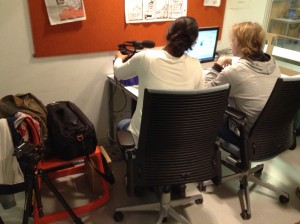
Preparation for user test
Besides these, we used hotspots in our demo movies. A hotspot is something that if you interactive with, you will receive an appropriate feedback. For example, in Date Scene, one of our demo movie, if you stared at sky when hearing somebody talking about the weather, it will turn to rain. We are going to use this idea to add interactive elements into our final project.
Depends on the result of user test, we found out that using visual effects in filmed footage is a good option, and timing of hotspots needs intricate planning. furthermore, sound setup for narration is not that technically demanding. We are trying to use these results to improve our final project’s user experience.
Today we had a workshop about tinkering and prototyping. We made a cardboard oculus rift and acted out a murder mystery scene. When the user put on our paper prototype, he was transported to our “virtual reality.”
We started out by asking our test subject to put on our paper prototype and then told him he was being transported to our “Virtual Reality”. Our test subject could activate certain characters in the scene by looking at them for a certain amount of time. The character would then relay a message regarding the murder. When our test subject heard all the messages, he had to point out the murderer. We found this to be a great way to test out scene’s for the Oculus and we will probably use it in the future.
Acting out the scene felt a lot like theater play. Theater is actually the medium that lies closest to virtual reality at the moment. It deals with a lot of the same problems, one of them being the freedom to look around you. It’s the director’s job to direct the attention of the audience to the desired location.
We will have to do the same thing in our VR movie, in order to prevent the user missing important events around him.
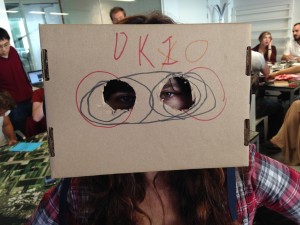
In the first part of the project we will be working with demos provided by WeMakeVr. Our job is to tweak the demos, for example by adding 3d binaural sound to make the experience as immersive as possible. Today a journalist of the Volkskrant, who is writing an article about the future of cinema, joined us on a tour of the VR demo’s made by WeMakeVR. When you first experience virtual reality it’s a jaw dropping experience. As soon as the Oculus slides in front of your eyes, you can feel your consciousness shifting to a different location. You’re not sitting in a chair in Amsterdam anymore, but you’re standing in a beautiful garden in Tuscany.
The second demo was shot with a special camera system made by WeMakeVR. The camera can film 360 degrees, horizontally and vertically, so you can see everything around you. In the demo you sit in a boat that’s navigating through the canals of Amsterdam. Even though the footage is shot with a camera, the depth perception is perfect; once again you feel present in the virtual world. When a tour boat passes by your first impulse is to wave to the people in the other boat.

















